How to Make Different Types of Paints - Emulsion and Gloss
Today, paints are used for interior and exterior house-painting, boats, automobiles, planes, appliances, furniture, and many other places where protection and aesthetic appreciation are desired. Paint is an essential commodity that does not just beautify but also serves as a protective measure on any surface it is applied. Thus there is always a demand for it at any place any time.
This is an opportunity to own your own paint production industry. With our wide experience in the manufacturing of different kind paints, both emulsion (water-based)) and gloss (oil-based), here you will get to know all our formulae and techniques so you can produce different types of paints, either you are producing for your own use or for commercial purposes.
Here, we offer you an ebook that will teach you the following:
The production cost is very low but the outcome is quite profitable, so paint production is a great business opportunity you should consider. Some people have the wrong notion that you need a large factory or capital to start this business. That is not true; you can start producing paints even in your backyard. All you need is the capital to get you the required chemicals, the packaging materials and a small mixing machine if you don't want to mix manually.
There are two (2) broad classes of paints, namely:
This book will give you all that you need to know about producing any of the classes above. You’ll get to know the details of all the chemicals required for making either oil-based paint or water-based paint. Each of the classes above still has different types. This book gives you different formulae for different types of water based and oil based paints.
The different types of water-based paints that we cover in this ebook are:
Solvents are various low viscosity, volatile liquids. They include petroleum, mineral spirits and aromatic solvents such as benzol, alcohols, esters, ketones, and acetone. The natural resins most commonly used are linseed, coconut oil, and soybean oil, while alkyds, acrylics, epoxies, and polyurethanes number among the most popular synthetic resins. Additives serve many purposes. Some, like calcium carbonate and aluminium silicate, are simply fillers that give the paint body and substance without changing its properties. Other additives produce certain desired characteristics in paint, such as the thixotropic agents that give the paint its smooth texture, driers, anti-settling agents (called dispersants in this book), anti-skinning agents, defoamers, and a host of others that enable the paint to cover well and last long.
This manual is directed towards production and formulation of emulsion paint (water –based paint) and gloss (oil-based paints) from raw materials that can be sourced locally. The high demand for paints for protective and decorative purposes has encouraged the development of different types of equipment for the manufacturing operation.
The following are the chemical/constituents we use in the production of paint:
Solvent serves as a vehicle for the main ingredients of the paint. Solvents also increase the overall volume of the paint. Solvents may be:
For water-based paint commonly called emulsion, water is used to mix all the chemicals together. It must not be hot water. You can use any type of clean water with normal water temperature. However, soft water is preferable in paint making because it helps to mix the paints more easily.
Resin
This is the binding and forming part. The resin used could be polyvinyl acetate (PVA), for water-based paints; or Alkyd Resin, for oil-based paints. However, there are different types of PVA, namely: acrylic resin (polyvinyl acrylate), Acrona PVA, and Vinumal PVA (used for water-based paints).
P.V.A is very important in paint making. I guess you might have seen a situation where after painting a building when you rub your hand on the surface the paint would seem to flake off or stain your hands. That is as a result of ill usage of P.V.A.
Either acrylic, acronal P.V.A, or vinamul P.V.A is used as a binder for water-based paints. It is the resin used and the quantity used that determines the quality of the paint. Correct usage will prevent your paint from staining (chalking or rubbing off easily when the painted wall or object is touched).
Alkyd resin is used as a binder for oil-based paints.
In my experience, some big names in the paint manufacturing industry do not even know how to use resin correctly or they are probably trying to cut cost at the expense of the quality of the final product. That’s why most emulsion paints in the market today will stain your body if you mistakenly rub your body against a painted wall or object. But do not worry, I will tell you how to use it correctly and who knows you might become the next consultant in the paint making industry.
Titanium dioxide (Titan)
This chemical is used majorly in the production of white paint. It is, however, necessary in various lower quantities, in the production of other coloured paints. It is a whitening chemical in powder form. It performs the function of making sure that your white paint is shining and not dull. This is the secret of some big names in the painting industry. We shall give you the ratio down the line.
Fillers
These are components that give body to the paint. They include calcium carbonate (commonly called Calcium by the market people), and kaolin clay (a white powdery substance which is also used as a filler in soap production to reduce cost). Let me talk about calcium carbonate a little, so you have an idea of what it's about.
Calcium Carbonate (a filling agent in paint)
The market people normally call it calcium, i.e. without the addition of carbonate to the name. This means you can go to any shop that sells paint chemicals and ask for calcium, it’s the same as calcium carbonate. This chemical is also in powder form. It is packaged in bags and they write CalCo or the chemical formula, CaCO3 on it.
Note that calcium carbonate is of two types. We have dolomite and calcite. Both are good but dolomite is recommended if you are producing pure white paint and calcite is better in off white (dirty white) paint production.
Colourants (Pigments)
A colourant is a colouring agent that adds colour and body to your paint. It comes in different types of colours usually called primary colours. Every other colour is obtained from a combination of the primary colours. Colouring is one of the most important aspects of paint making procedures. It involves the ability to mix some colours to get the desired result. It is not difficult at all if you have initiative and artistic eye.
Colourants come in any of these colours called primary colours. They are yellow (we painters call it cream), Red, Black, Blue, and Green. All other colours are gotten from a combination of two or more of these.
What about White paint? You might ask. Well, we do not need to have a pure white colour because we make our paints with calcium carbonate (CalCo or scientifically CaCO3) and it gives us white naturally. In fact, once you put your calcium carbonate in water you get white paint. I hope that is clear. To make the white shiny, bright and attractive, you add titanium dioxide.
Pigments could be colour oxide for coloured paints or titanium dioxide for white paints. We shall cover how to mix colours to get a particular result. But for now, just know that colours can be found in paste or oxide. When we say colours are in paste; we mean that they are in semi-solid or condensed liquid form (like your pomade), when they are in oxide it means they are in dust form (like your face powder). A colour like cream has both oxide and paste. Red and black are mostly in oxide, green and blue are in paste form.
For those who might be wondering which one to use between the yellow oxide and yellow paste, I suggest that if you want the colour you are producing to be deep yellow like MTN colour, you should use paste, otherwise use oxide.
Combination of colours will get you any colour you like. However, the formula for this combination has no definition as you can use only one colourant to produce about 3 paints depending on the quantity you put.
In general, if you are looking for off-white colour, add a small quantity of yellow oxide to your paint. For light calabash, colour use yellow oxide and a little red in the ratio of [details available in the manual]. Indeed it is more of creativity. But the secret is that you make a correct measurement of the quantity of colours you put so that all the colours of your company will be the same.
CAUTION: You MUST dilute the colours very well with a little water before you apply it to your paint. For example, if you get a red oxide, pour a cup of water in a different container and mix thoroughly. If not, your paint will have dotted stains as you roll it on the wall.
Primary colour: These are the basic colours which include Red, Blue and Yellow.
Secondary Colours: These are the combination of two or more primary colours to achieve the desired colour. For example,
Blue + Yellow = Green
Red + Yellow = Orange
Red + Blue = Purple
Yellow + White = Cream
Blue + White = Sky Blue
White + Black = Grey
Little Red + More Blue = Lilac
Yellow + Black = Beige
Red + Black = Brown
Red + Yellow + Black = Abuja Brown
Tertiary Colours: These are the combination of two or more secondary colours or the combination of a secondary colour and primary colour to give the desired colour. For example,
Green + Yellow = Lemon
Green + Red = Brown
Orange + Blue = Brown
Cream +Little Brown = Abuja Brown
Note: Most colours, be it primary or secondary are now present in the market, meaning you don’t need to stress yourself mixing primary or secondary colours to get a desired coloured.
Preservatives
These are chemicals that help to prolong the life span of paints. Preservatives are mainly used for water-based paints. The chemicals used as preservatives may include but not limited to the following:
Preservatives increase the shelf life of the produced paint. Permit me to talk about ammonia in particular.
Ammonia
This is a strong pungent smelling liquid that smells exactly like urine. Apart from serving as a biocide, ammonia is also used to make the paints more durable i.e. it serves as a preservative agent.
Thickeners
As the name implies, they help in thickening the paints. Examples of chemicals used as thickeners are:
Again, I will like to talk about natrosol, acrytext and bama cork a bit.
Natrosol: This is a thickening agent that helps to hold the paints together and prevents the pigment from settling down. It’s majorly used for water-based paints. Its correct usage makes the paint more durable on the wall.
Acrytext: Acrytext is also a thickening agent. It holds the seemingly watery paint together.
Bama cork: It does the function of natrosol (which is thickening). If you use bama cork you do not need to use natrosol.
Buffer
Buffer makes the thickener to react fast.
Biocide
These are chemicals that kill microorganisms like algae, fungi, and that do not allow grass to grow on the surface of painted walls. Examples of biocide include ammonia and anticide.
Defoamer
This chemical reduces foaming in paints during the production process.
Anti-skin (MEKO)
This chemical serves as an anti-caking agent
Brighteners
These chemicals help to correct the dullness of paints, they help in bringing out the brightness of paints, especially for white and light coloured paints. You don’t use them for dark colour paint production. Examples of brighteners are hydrosol (for white and light colour paints), and aluminum silicate (for white colour paints only). Let me talk about hydrosol a little.
Hydrosol: As stated above this is one of the chemicals that integrates the colours and brings out the best in them. It is used to correct dullness in paints and it is used for both white and light coloured paints production.
Marble Dust
Marble dust is only required if you want to produce a type of paint called textcoat. A textcoat paint is a paint that has kind of rough texture that appears as if stone or sand particles were mixed with the paint before the wall is painted.
There are two types of marble dust, namely the rough one and the smooth one. The type you choose, whether rough or smooth, is determined by what you want to achieve. If you want sandy textcoat i.e. the one without lining, you use only rough type. However, the combination of both in the same ratio gives a better result
Dispersants
These chemicals help to reduce the tendency of solid materials in the paint to settle at the bottom of the mixer during production and even after the paint has been packaged for sale. Without the dispersants, the solid constituents of paints will settle at the bottom over time. Examples of chemicals used as dispersants include genopur and Calgon.
Apart from functioning as a dispersant, genopur also functions as a kind of fragrance that does the function of giving the paipaintsnter a scintillating perfume as he does his job.
Driers
These are catalysts which speed up the drying of paints. They carry oxygen into the paint and make it dry through oxidation, polymerization and condensation. Examples of chemicals used as driers are:
And to those who think that I will scam you of Three Thousand Naira (NGN7,500), please begin to think differently. Go through the following testimonials and change your mindset.
Note:
If I didn't scam any of them, why should I start with you.
And the second part of his testimonial
Let me give a little brief of his testimonial.
This person (from Jos) has his doubt (just like you) but somehow he gave it a try and made payment for the ebook. Of course, as usual, I delivered the book to him immediately and his trust level increased. Unfortunately he couldn't get all the chemicals in his location and those that are available were very expensive (cos they were laboratory grade).
Consequently, he opted in to send money to me so I could buy the chemicals and send to him. That bought another issue of trust again, but somehow he gave it a try again. He sent NGN15,000 to buy the chemicals in bulk.
As usual, I bought the chemicals and send to him, he was able to receive the chemicals the next day. Take note of the images above and see where I highlighted the image with boxes (the first image in particular). I'm sure you can see the conversation indicated with green and red box in the first image which reads as follows:
If this guy could pay for the ebook, I didn't scam him but deliver, it didn't end there, he sent NGN15,000 for the chemicals, I still didn't scam him for 15K, is it 3K I will scam you of? Common change your thinking.
I strike out some part of the text because there's no way I will give you my formula for free. I didn't get it free. That apply to every other images here, where part of the text has been cut out.
This guy overcame his doubt, gave it a try and now he's a happy owner of a lucrative business in Jos. It can also be you.
This is actually for Paint Making Ebook. This guy all the way from Congo, saw the paint production ebook and coughed out NGN7,500 for the full package. He made payment through Western Union, he even added extra NGN138.18 as you can see in the screenshot above (indicated with light purple colour in the image above).
If a Congolese could trust me enough to send money for my ebook, I did not scam him but sent the ebook and now he can be a proud owner of paint production business in his country, why should I scam you.
So, if you are reading this from any part of the world and you are interested in any of my ebook, you can get it. Just contact me on WhatsApp (+2348187664783) or Telegram (@Alexis29), let's work out how you can get it.
The continuation of his testimonial
This is a testimonial of a buyer from Ekiti state. He bought the manual but could not get some of the chemicals. Take note of where I highlighted the image above. The conversation reads as follows:
I indicated it with a green box in the first image above. If I didn't scam him of NGN12,000 why should I scam you of NGN3,000. Change your thinking.
Now, after production, look at his lengthy testimonial, where I indicated with orange box in the second image. The testimonial reads thus:
I hope you can see the testimonial yourself in the image above. Today he is a happy owner of ink production business.
You can see the conversation from the image yourself. People are buying my formulations from around the world, but the doubting thomases Nigerians are still holding back. Are you one of them? Please, change your thinking (for your own good).
You can see clearly where I highlighted the image with a coloured box, he stated he's from Brazil. He bought both the ink and paint manual. He paid through PayPal, as it can be seen from the screenshot (his payment receipt is there). You can read the screenshot by yourself. So, if you are in Brazil reading this and you need any of the manuals sold on this website, just hit me up on WhatsApp or any other social media as listed here.
Look at the conversation in the image above. This man (PhD holder) all the way from Iran was able to make a way of paying for this manual (he paid through PayPal) and as usual, the ebook was delivered to him. Check his phone number yourself (+98915246......), you can see that that's Iranian phone number.
If a PhD holder all the way from Iran could pay for this manual, what is a primary school holder like me still waiting for? Get it today and be a proud owner of a lucrative business.
You can read it yourself from the screenshot, he clearly mentioned he's from Kenya. He paid through Western Union. Distance is never a barrier as long as you can use any of the payment methods (Direct bank transfer, PayPal or Western Union). His payment receipt and tracking number is there, you can see it yourself.
I just decided to add this because of the unique payment receipt above and my delivery proof. There are many of this type but, of course, I can't put all on the website.
Of course, I can't put all the testimonials here. These are just randomly selected ones. Some testimonials are, of course, phone calls. A man from Abuja NGN30,000 for chemicals, another from Keffi, Nassarawa, sent NGN15,000, one from Niger sent NGN14,000 and so many others like that. They all sent their testimonials through phone calls.
These are just few selected testimonials to prove that:
This is an opportunity to own your own paint production industry. With our wide experience in the manufacturing of different kind paints, both emulsion (water-based)) and gloss (oil-based), here you will get to know all our formulae and techniques so you can produce different types of paints, either you are producing for your own use or for commercial purposes.
Here, we offer you an ebook that will teach you the following:
- The various chemicals used in paint production
- The individual function(s) of each of the chemicals
- The quantities of each chemical that make a drum of paint
- The procedures used in mixing the different chemicals so as to achieve the desired result
- The various equipment and tools used in paint production
- The marketing strategies for new paint producers
- The general guidelines for paint production.
The production cost is very low but the outcome is quite profitable, so paint production is a great business opportunity you should consider. Some people have the wrong notion that you need a large factory or capital to start this business. That is not true; you can start producing paints even in your backyard. All you need is the capital to get you the required chemicals, the packaging materials and a small mixing machine if you don't want to mix manually.
There are two (2) broad classes of paints, namely:
- Oil-based paint
- Water based paint
This book will give you all that you need to know about producing any of the classes above. You’ll get to know the details of all the chemicals required for making either oil-based paint or water-based paint. Each of the classes above still has different types. This book gives you different formulae for different types of water based and oil based paints.
Types of Water-Based Paints Covered In This Ebook
Water-based paints as the name implies is a type of paint in which the carrier solvent is water. In this ebook, we discuss 12 different types of water-based paints, their chemical constituents, formulae and production procedures.The different types of water-based paints that we cover in this ebook are:
- Emulsion Paint
- Textured Paint
- Flextured Paint
- Satin or Nylon Paint
- POP Paint
- Matt Eggshell
- Flex Coat Paint
- Textured Matt Paint
- Marble Trowel Paint
- Marble Effect Paint
- Base Coat Paint
- Graffitex Paint
Production of Water-Based Paints
Raw Materials
Paint is composed of pigments, solvents, resins, and various additives. The pigments give the paint colour; solvents make it easier to apply; resin seems to function as a binding agent and helps the paint to dry, and additives serve as everything from fillers to anti-fungicidal agents. Hundreds of different pigments, both natural and synthetic, exist. The basic white pigment is titanium dioxide, selected for its excellent concealing properties, and black pigment is commonly made from carbon black. Other pigments used to make paint include iron oxide and cadmium sulfide for reds, metallic salts for yellows and oranges, and iron blue and chrome yellows for blues and greens.Solvents are various low viscosity, volatile liquids. They include petroleum, mineral spirits and aromatic solvents such as benzol, alcohols, esters, ketones, and acetone. The natural resins most commonly used are linseed, coconut oil, and soybean oil, while alkyds, acrylics, epoxies, and polyurethanes number among the most popular synthetic resins. Additives serve many purposes. Some, like calcium carbonate and aluminium silicate, are simply fillers that give the paint body and substance without changing its properties. Other additives produce certain desired characteristics in paint, such as the thixotropic agents that give the paint its smooth texture, driers, anti-settling agents (called dispersants in this book), anti-skinning agents, defoamers, and a host of others that enable the paint to cover well and last long.
This manual is directed towards production and formulation of emulsion paint (water –based paint) and gloss (oil-based paints) from raw materials that can be sourced locally. The high demand for paints for protective and decorative purposes has encouraged the development of different types of equipment for the manufacturing operation.
The following are the chemical/constituents we use in the production of paint:
- Water
- Titanium dioxide (used only for the production of white paint)
- Fillers
- Colourants
- Resins
- Preservatives
- ThickenersHydrosol
- Marble Dust
- Acrydext/ Acrylic
- Dispersant
- Driers
- K14
- Buffer
- Defoamer
- Anti-skin (MEKO)
- Bama cork
Functions of Each of the Chemicals Above
SolventSolvent serves as a vehicle for the main ingredients of the paint. Solvents also increase the overall volume of the paint. Solvents may be:
- Water: for water-based paints;
- Petrol, kerosene or toluene: for oil-based paints.
For water-based paint commonly called emulsion, water is used to mix all the chemicals together. It must not be hot water. You can use any type of clean water with normal water temperature. However, soft water is preferable in paint making because it helps to mix the paints more easily.
Resin
This is the binding and forming part. The resin used could be polyvinyl acetate (PVA), for water-based paints; or Alkyd Resin, for oil-based paints. However, there are different types of PVA, namely: acrylic resin (polyvinyl acrylate), Acrona PVA, and Vinumal PVA (used for water-based paints).
P.V.A is very important in paint making. I guess you might have seen a situation where after painting a building when you rub your hand on the surface the paint would seem to flake off or stain your hands. That is as a result of ill usage of P.V.A.
Either acrylic, acronal P.V.A, or vinamul P.V.A is used as a binder for water-based paints. It is the resin used and the quantity used that determines the quality of the paint. Correct usage will prevent your paint from staining (chalking or rubbing off easily when the painted wall or object is touched).
Alkyd resin is used as a binder for oil-based paints.
In my experience, some big names in the paint manufacturing industry do not even know how to use resin correctly or they are probably trying to cut cost at the expense of the quality of the final product. That’s why most emulsion paints in the market today will stain your body if you mistakenly rub your body against a painted wall or object. But do not worry, I will tell you how to use it correctly and who knows you might become the next consultant in the paint making industry.
Titanium dioxide (Titan)
This chemical is used majorly in the production of white paint. It is, however, necessary in various lower quantities, in the production of other coloured paints. It is a whitening chemical in powder form. It performs the function of making sure that your white paint is shining and not dull. This is the secret of some big names in the painting industry. We shall give you the ratio down the line.
Fillers
These are components that give body to the paint. They include calcium carbonate (commonly called Calcium by the market people), and kaolin clay (a white powdery substance which is also used as a filler in soap production to reduce cost). Let me talk about calcium carbonate a little, so you have an idea of what it's about.
Calcium Carbonate (a filling agent in paint)
The market people normally call it calcium, i.e. without the addition of carbonate to the name. This means you can go to any shop that sells paint chemicals and ask for calcium, it’s the same as calcium carbonate. This chemical is also in powder form. It is packaged in bags and they write CalCo or the chemical formula, CaCO3 on it.
Note that calcium carbonate is of two types. We have dolomite and calcite. Both are good but dolomite is recommended if you are producing pure white paint and calcite is better in off white (dirty white) paint production.
Colourants (Pigments)
A colourant is a colouring agent that adds colour and body to your paint. It comes in different types of colours usually called primary colours. Every other colour is obtained from a combination of the primary colours. Colouring is one of the most important aspects of paint making procedures. It involves the ability to mix some colours to get the desired result. It is not difficult at all if you have initiative and artistic eye.
Colourants come in any of these colours called primary colours. They are yellow (we painters call it cream), Red, Black, Blue, and Green. All other colours are gotten from a combination of two or more of these.
What about White paint? You might ask. Well, we do not need to have a pure white colour because we make our paints with calcium carbonate (CalCo or scientifically CaCO3) and it gives us white naturally. In fact, once you put your calcium carbonate in water you get white paint. I hope that is clear. To make the white shiny, bright and attractive, you add titanium dioxide.
Pigments could be colour oxide for coloured paints or titanium dioxide for white paints. We shall cover how to mix colours to get a particular result. But for now, just know that colours can be found in paste or oxide. When we say colours are in paste; we mean that they are in semi-solid or condensed liquid form (like your pomade), when they are in oxide it means they are in dust form (like your face powder). A colour like cream has both oxide and paste. Red and black are mostly in oxide, green and blue are in paste form.
For those who might be wondering which one to use between the yellow oxide and yellow paste, I suggest that if you want the colour you are producing to be deep yellow like MTN colour, you should use paste, otherwise use oxide.
Combination of colours will get you any colour you like. However, the formula for this combination has no definition as you can use only one colourant to produce about 3 paints depending on the quantity you put.
In general, if you are looking for off-white colour, add a small quantity of yellow oxide to your paint. For light calabash, colour use yellow oxide and a little red in the ratio of [details available in the manual]. Indeed it is more of creativity. But the secret is that you make a correct measurement of the quantity of colours you put so that all the colours of your company will be the same.
CAUTION: You MUST dilute the colours very well with a little water before you apply it to your paint. For example, if you get a red oxide, pour a cup of water in a different container and mix thoroughly. If not, your paint will have dotted stains as you roll it on the wall.
Colour Combination in Paint Making
The knowledge of colour combination cannot be overemphasized in paint production. As state earlier colour is divided into:- Primary colour
- Secondary colour
- Tertiary colour
Primary colour: These are the basic colours which include Red, Blue and Yellow.
Secondary Colours: These are the combination of two or more primary colours to achieve the desired colour. For example,
Blue + Yellow = Green
Red + Yellow = Orange
Red + Blue = Purple
Yellow + White = Cream
Blue + White = Sky Blue
White + Black = Grey
Little Red + More Blue = Lilac
Yellow + Black = Beige
Red + Black = Brown
Red + Yellow + Black = Abuja Brown
Tertiary Colours: These are the combination of two or more secondary colours or the combination of a secondary colour and primary colour to give the desired colour. For example,
Green + Yellow = Lemon
Green + Red = Brown
Orange + Blue = Brown
Cream +Little Brown = Abuja Brown
Note: Most colours, be it primary or secondary are now present in the market, meaning you don’t need to stress yourself mixing primary or secondary colours to get a desired coloured.
Preservatives
These are chemicals that help to prolong the life span of paints. Preservatives are mainly used for water-based paints. The chemicals used as preservatives may include but not limited to the following:
- Ammonia
- Formalin
- Anticide
- Sodium Benzoate
- K14
Preservatives increase the shelf life of the produced paint. Permit me to talk about ammonia in particular.
Ammonia
This is a strong pungent smelling liquid that smells exactly like urine. Apart from serving as a biocide, ammonia is also used to make the paints more durable i.e. it serves as a preservative agent.
Thickeners
As the name implies, they help in thickening the paints. Examples of chemicals used as thickeners are:
- Natrosol (used mainly for water-based paints)
- Easy Gel (used mainly for oil-based paints)
- Acrytext
- G14
- Bama cork
Again, I will like to talk about natrosol, acrytext and bama cork a bit.
Natrosol: This is a thickening agent that helps to hold the paints together and prevents the pigment from settling down. It’s majorly used for water-based paints. Its correct usage makes the paint more durable on the wall.
Acrytext: Acrytext is also a thickening agent. It holds the seemingly watery paint together.
Bama cork: It does the function of natrosol (which is thickening). If you use bama cork you do not need to use natrosol.
Buffer
Buffer makes the thickener to react fast.
Biocide
These are chemicals that kill microorganisms like algae, fungi, and that do not allow grass to grow on the surface of painted walls. Examples of biocide include ammonia and anticide.
Defoamer
This chemical reduces foaming in paints during the production process.
Anti-skin (MEKO)
This chemical serves as an anti-caking agent
Brighteners
These chemicals help to correct the dullness of paints, they help in bringing out the brightness of paints, especially for white and light coloured paints. You don’t use them for dark colour paint production. Examples of brighteners are hydrosol (for white and light colour paints), and aluminum silicate (for white colour paints only). Let me talk about hydrosol a little.
Hydrosol: As stated above this is one of the chemicals that integrates the colours and brings out the best in them. It is used to correct dullness in paints and it is used for both white and light coloured paints production.
Marble Dust
Marble dust is only required if you want to produce a type of paint called textcoat. A textcoat paint is a paint that has kind of rough texture that appears as if stone or sand particles were mixed with the paint before the wall is painted.
There are two types of marble dust, namely the rough one and the smooth one. The type you choose, whether rough or smooth, is determined by what you want to achieve. If you want sandy textcoat i.e. the one without lining, you use only rough type. However, the combination of both in the same ratio gives a better result
Dispersants
These chemicals help to reduce the tendency of solid materials in the paint to settle at the bottom of the mixer during production and even after the paint has been packaged for sale. Without the dispersants, the solid constituents of paints will settle at the bottom over time. Examples of chemicals used as dispersants include genopur and Calgon.
Apart from functioning as a dispersant, genopur also functions as a kind of fragrance that does the function of giving the paipaintsnter a scintillating perfume as he does his job.
Driers
These are catalysts which speed up the drying of paints. They carry oxygen into the paint and make it dry through oxidation, polymerization and condensation. Examples of chemicals used as driers are:
- Texanol, for water-based paints
- Mixed drier, for oil-based paints
Steps to making Different Types of Paints
Like I stated earlier, in this ebook you're going to learn everything you need to know to produce the following types of paints:
Water-Based Paints
- Ordinary emulsion paints
- POP emulsion paint
- Textured paint (textcoat)
- Flextured paint
- Satin (nylon) paint
- Matt eggshell paint
- Flexcoat paint
- How to do marble effect with paint
- Production of base coat
- Production of textured matt
- Production of marble trowel
- Production of graffitext
Production of Gloss paints (Oil-Based Paints)
- Gloss paint
- Varnish
- Undercoat
- Anti-rust
Lastly, you will learn where to buy chemicals and other needed equipment for production process and packaging. The general guidelines for successful operation and marketing strategies are also covered.
How Much is the Ebook?
Good question! I lot of people I've come across in the course of searching for where to learn how to produce all these charged me as high as NGN30,000 - NGN50,000. There was a time I wanted to buy a video on the production of gloss paint only, the seller told me to bring NGN35,000 (Thirty-Five Thousand Naira) just for one video.
I'm not going to charge you as high as that because I really want you to start as early as possible. So, how much are you going to pay to get this book?
In order to help as many people as possible, I'm offering it for:
a meagre sum of:
NGN7,500 (Seven Thousand Five Hundred Naira only).
($19.75)
How to Order
To order for the manual, pay the sum of NGN 7,500 to any of the following account details:
GTBank
- Account Name: Alexander Ubokwe
- Account Number: 0129351105
- Bank: GTBank
Access Bank
- Account Name: Alexander Ubokwe
- Account Number: 0095965843
- Bank: Access Bank
After payment, send an SMS with your payment details to 08081862062 or send a WhatsApp message with your payment details to 08187664783.
- Name of depositor
- Amount Paid
- Material paid for (Paint making manual)
- Date of payment
- Your email address or chat me up on WhatsApp (+2348187664783).
Once I receive your message, I will send the manual to your email address provided.
Note: The card payment option below works for both non-Nigerians, so if you are outside Nigeria and you are interested in this book, you can pay with your debit or credit card. Click the link below and be redirected to a SECURED payment page.
Pay with Card
Testimonials
To the doubting "Thomases" out there where think everything on the internet is not real, these testimonials will prove you wrong.And to those who think that I will scam you of Three Thousand Naira (NGN7,500), please begin to think differently. Go through the following testimonials and change your mindset.
Note:
- The testimonials were sent through WhatpsApp conversations, so the following are just screenshot of the conversations.
- Also note that most of the testimonials here are from those who bought the ink ebook,
- others are from those who bought the paint ebook,
- some from those who bought the cosmetics ebook; and
- the rest from those who sent money to me to help them chemicals and send to their locations.
If I didn't scam any of them, why should I start with you.
Testimonial from a Customer in Jos
And the second part of his testimonial
Let me give a little brief of his testimonial.
This person (from Jos) has his doubt (just like you) but somehow he gave it a try and made payment for the ebook. Of course, as usual, I delivered the book to him immediately and his trust level increased. Unfortunately he couldn't get all the chemicals in his location and those that are available were very expensive (cos they were laboratory grade).
Consequently, he opted in to send money to me so I could buy the chemicals and send to him. That bought another issue of trust again, but somehow he gave it a try again. He sent NGN15,000 to buy the chemicals in bulk.
As usual, I bought the chemicals and send to him, he was able to receive the chemicals the next day. Take note of the images above and see where I highlighted the image with boxes (the first image in particular). I'm sure you can see the conversation indicated with green and red box in the first image which reads as follows:
Good morning sir, I saw your message yesterday but your number isn't going through. I called the driver this morning and he said they are still on their way. I thank you so much sir, you are really a trustworthy man. May God prosper your ways.
If this guy could pay for the ebook, I didn't scam him but deliver, it didn't end there, he sent NGN15,000 for the chemicals, I still didn't scam him for 15K, is it 3K I will scam you of? Common change your thinking.
How about the result of his production?
Take note of the second image where I indicated with a green box. The message reads:I have produced 1 liter so far, it was just so excellent, sir. I measured _______ of colorant. I mixed them and saw how good it was. Thanks sir, you are the one that made it possible.
I strike out some part of the text because there's no way I will give you my formula for free. I didn't get it free. That apply to every other images here, where part of the text has been cut out.
This guy overcame his doubt, gave it a try and now he's a happy owner of a lucrative business in Jos. It can also be you.
A Buyer from Congo (Democratic Republic of Congo)
This is actually for Paint Making Ebook. This guy all the way from Congo, saw the paint production ebook and coughed out NGN7,500 for the full package. He made payment through Western Union, he even added extra NGN138.18 as you can see in the screenshot above (indicated with light purple colour in the image above).
If a Congolese could trust me enough to send money for my ebook, I did not scam him but sent the ebook and now he can be a proud owner of paint production business in his country, why should I scam you.
So, if you are reading this from any part of the world and you are interested in any of my ebook, you can get it. Just contact me on WhatsApp (+2348187664783) or Telegram (@Alexis29), let's work out how you can get it.
Testimonial of a Buyer from Ekiti
The continuation of his testimonial
This is a testimonial of a buyer from Ekiti state. He bought the manual but could not get some of the chemicals. Take note of where I highlighted the image above. The conversation reads as follows:
I have sent 12,000 sir for all the materials. I will get back to you.
I indicated it with a green box in the first image above. If I didn't scam him of NGN12,000 why should I scam you of NGN3,000. Change your thinking.
Now, after production, look at his lengthy testimonial, where I indicated with orange box in the second image. The testimonial reads thus:
I don't know how to appreciate you sir, for your uprightness, sincerity and faithfulness,I thank God for you sir and for the life of our Lord Jesus Christ in you, you have done so much for me by empowering me ,as a Corper being concerned what next after service,I have spent about eighty something thousand since my eleven months of service which is about to end,both in research and in buying fake materials,in all this I have mate different fraudulents and risk and agony, nevertheless I have been persistent, hopefull and hard-working until this precious time when God sent you sir as the angel of help to me Just as to the Ethiopian Eunuch under the tree...., Very lengthy story, In Summary ,may the Lord and our savior Jesus Christ,see you through, bless your family, protect you, promote you, smash your enemies and lastly always remember this sacrifices you paid to me, here on Earth and then in eternity,And I say,AMEN IN JESUS NAME.
I hope you can see the testimonial yourself in the image above. Today he is a happy owner of ink production business.
A Buyer from Ghana
You can see the conversation from the image yourself. People are buying my formulations from around the world, but the doubting thomases Nigerians are still holding back. Are you one of them? Please, change your thinking (for your own good).
A Buyer from Brazil
You can see clearly where I highlighted the image with a coloured box, he stated he's from Brazil. He bought both the ink and paint manual. He paid through PayPal, as it can be seen from the screenshot (his payment receipt is there). You can read the screenshot by yourself. So, if you are in Brazil reading this and you need any of the manuals sold on this website, just hit me up on WhatsApp or any other social media as listed here.
A Buyer from Iran
Look at the conversation in the image above. This man (PhD holder) all the way from Iran was able to make a way of paying for this manual (he paid through PayPal) and as usual, the ebook was delivered to him. Check his phone number yourself (+98915246......), you can see that that's Iranian phone number.
If a PhD holder all the way from Iran could pay for this manual, what is a primary school holder like me still waiting for? Get it today and be a proud owner of a lucrative business.
A Buyer from Kenya
You can read it yourself from the screenshot, he clearly mentioned he's from Kenya. He paid through Western Union. Distance is never a barrier as long as you can use any of the payment methods (Direct bank transfer, PayPal or Western Union). His payment receipt and tracking number is there, you can see it yourself.
Payment and Delivery Proof
I just decided to add this because of the unique payment receipt above and my delivery proof. There are many of this type but, of course, I can't put all on the website.
Double Payment and Retrieval Testimonial
You can read the conversation yourself. Joy, because of network problem, paid twice. I didn't scam her of 6K but refund the extra 3K, why should I start with you.
Don't let your doubt or fear keep you behind. Get the ebook today and own a business.
Another Paint Manual Testimonial
This is for paint production ebook, but I decided to add it here too. It's part of my product and proof of authenticity of my formulations.
Skincare, Soap, Cosmetics and other Household Formulation ebook
Look at the image clearly, the phone number in particular. The same person that opted for paint production manual is the person that still bought the cosmetics, skincare, and other household consumables ebook.
One of the customers bought almost all the ebook I have on sale on this website. I could remember he bought ink, paint and cosmetics formulation ebooks.
A Customer from Umuahia
This is another testimonial from a guy in Umuahia. He bought the ebook and also sent money for chemicals. Today he's happily producing. I forget to include on this screenshot samples of his products pictures he sent to me.
It's clearly stated on the screenshot that he's from Lebanon. He opted for paint manual. So, if you are in Lebanon, you can get this manual. If you don't use PayPal, you can send the money through Western Union.
A Guy from Lebanon
Another Iranian Guy
Continuation of our conversation
You can read the conversation yourself. Take note of where he's praising me there. The text reads thus:
Wow, you're really good, Alex, thank you, wooowYou can see clearly from the image (first one), the statement was after I sent the manual to him. If I didn't scam him, why should I start with you.
Other Random Delivery Proofs
Yes, I tagged it "Random" because I just selected them randomly. I can't put everything here.Of course, I can't put all the testimonials here. These are just randomly selected ones. Some testimonials are, of course, phone calls. A man from Abuja NGN30,000 for chemicals, another from Keffi, Nassarawa, sent NGN15,000, one from Niger sent NGN14,000 and so many others like that. They all sent their testimonials through phone calls.
These are just few selected testimonials to prove that:
- I am real and deliver on my promises
- My formulations are genuine and work
- My business practices are trustworthy
Thanks for taking your time to read. Place your order for any of the ebook and start your own business today. You don't need any huge capital.


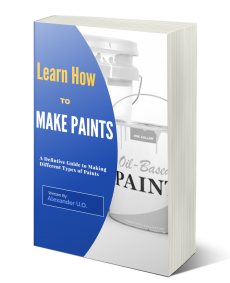
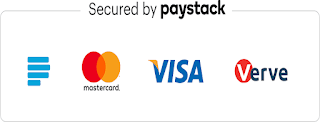
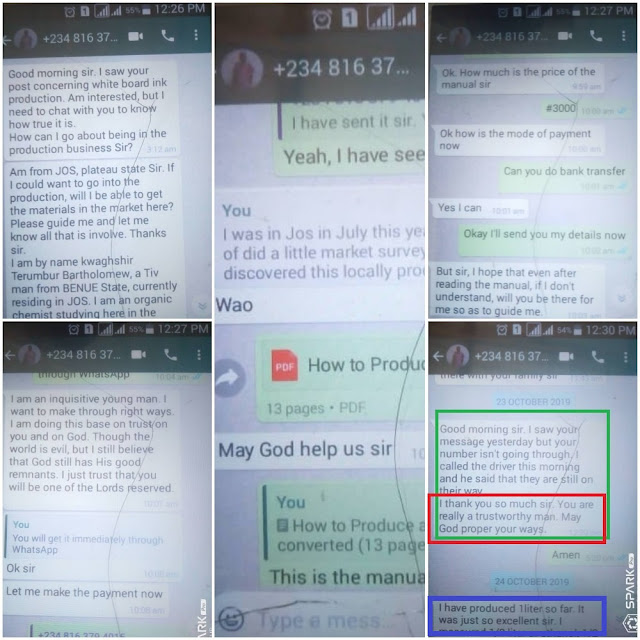
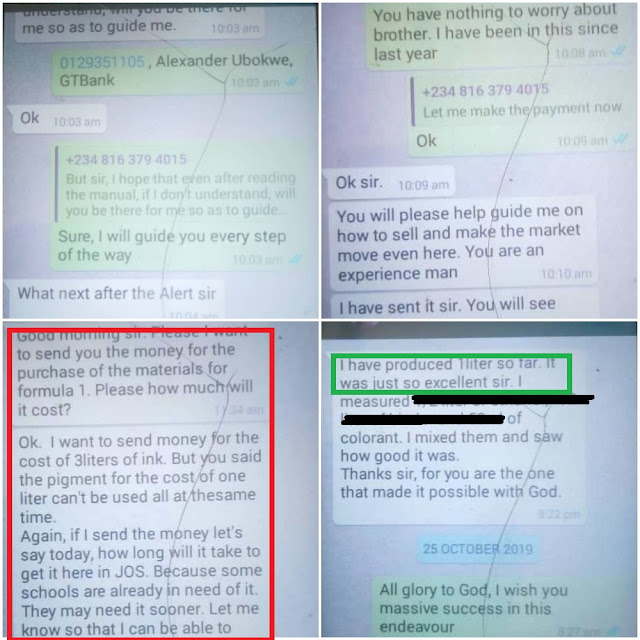


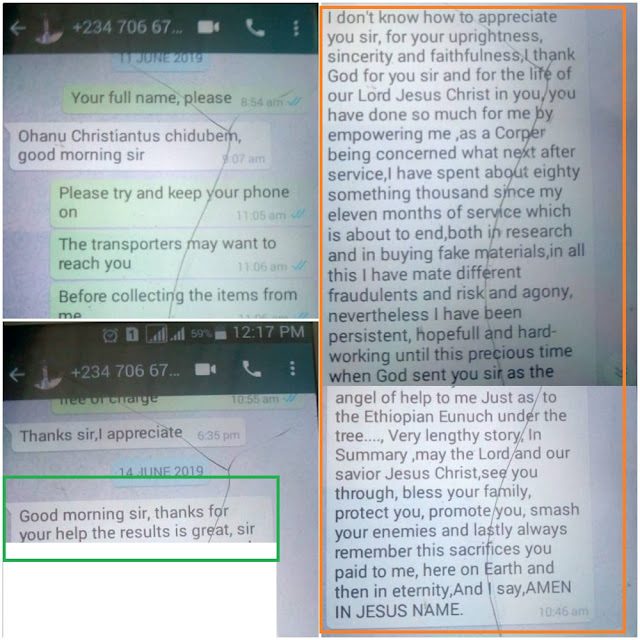

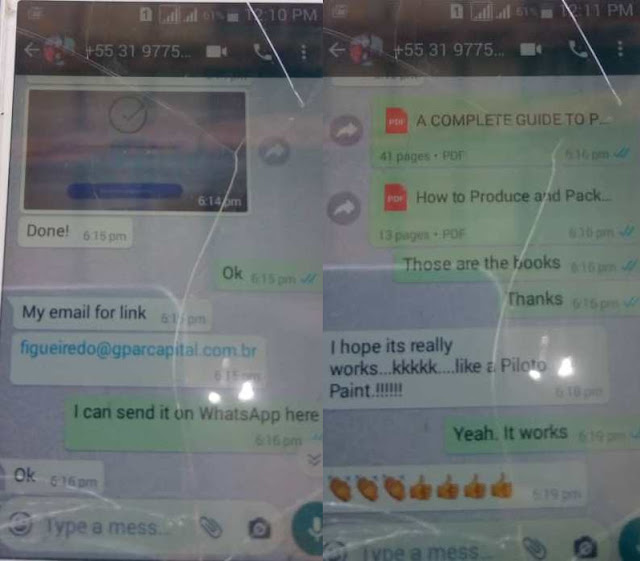
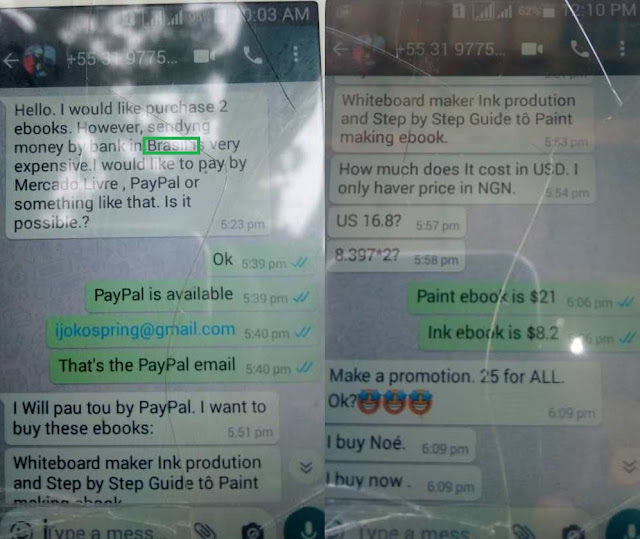

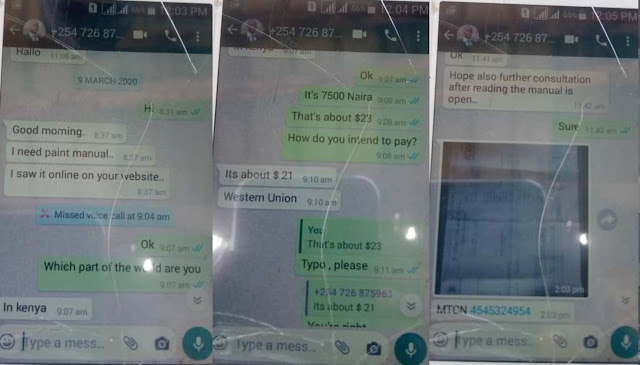





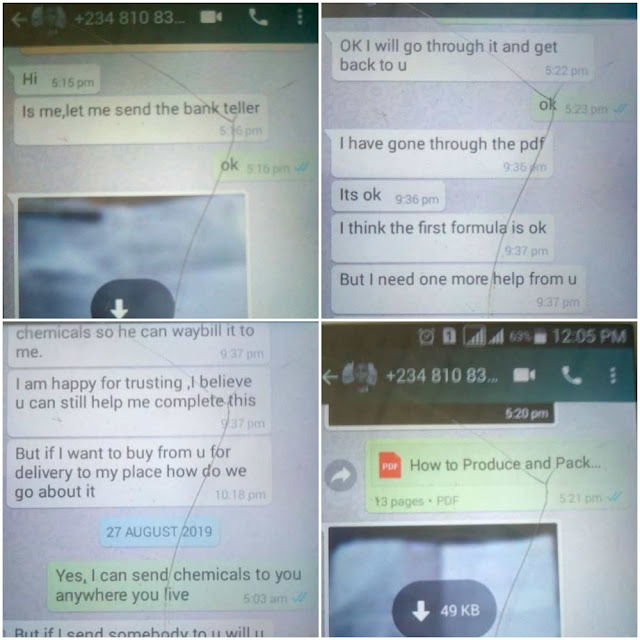
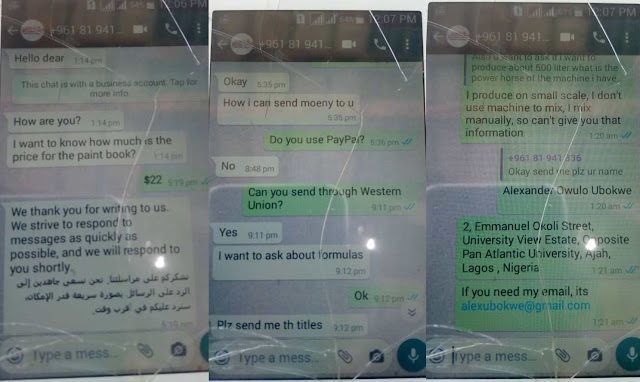























No comments